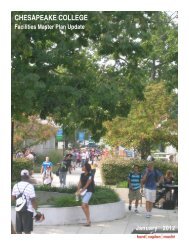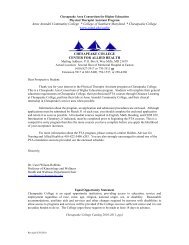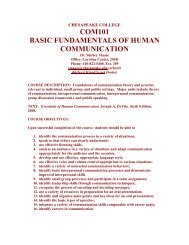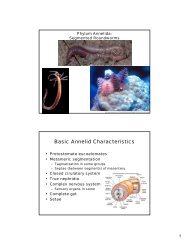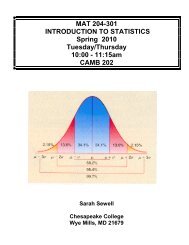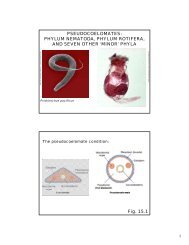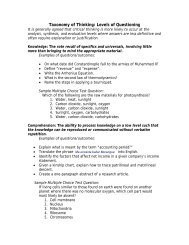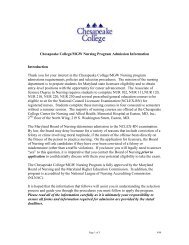Academic Calendar 2011-2012 - Chesapeake College
Academic Calendar 2011-2012 - Chesapeake College
Academic Calendar 2011-2012 - Chesapeake College
You also want an ePaper? Increase the reach of your titles
YUMPU automatically turns print PDFs into web optimized ePapers that Google loves.
AddendumC. Courses that are defined as general education by oneinstitution shall transfer as general education even ifthe receiving institution does not have that specificcourse or has not designated that course as generaleducation.D. The receiving institution shall give lower-division generaleducation credits to a transferring student who hastaken any part of the lower-division general educationcredits described in Regulation .03 of this Chapter ata public institution for any general education coursessuccessfully completed at the sending institution.E. Except as provided in Regulation .03L of this Chapter, areceiving institution may not require a transfer studentwho has completed the requisite number of generaleducation credits at any public college or university totake, as a condition of graduation, more than 10-16additional semester hours of general education andspecific courses required of all students at the receivinginstitution, with the total number not to exceed 46semester hours. This provision does not relieve studentsof the obligation to complete specific academicprogram requirements or course prerequisites requiredby a receiving institution.F. Each sending institution shall designate on or withthe student transcript those courses that have met itsgeneral education requirements, as well as indicatewhether the student has completed the general educationprogram.G. A.A.S. Degrees.(1) While there may be variance in the numbers ofhours of general education required for A.A.,A.S., and A.A.S. degrees at a given institution, thecourses identified as meeting general educationrequirements for all degrees shall come from thesame general education course list and excludetechnical or career courses.(2) An A.A.S. student who transfers into a receivinginstitution with fewer than the total number ofgeneral education credits as designated by thereceiving institution shall complete the differencein credits according to the distribution asdesignated by the receiving institution. Exceptas provided in §03M, the total general educationcredits for baccalaureate degree-grantingpublic receiving institutions shall not exceed46 semester hours.H. Student responsibilities. A student is held:(1) Accountable for the loss of credits that:(a) Result from changes in the individual’sselection of the major program of study;(b) Were earned for remedial coursework; or(c) Exceed the total course credits accepted intransfer as allowed by this Chapter.(2) Responsible for meeting all requirements ofthe academic program of the receivinginstitution.(2) The first two years of the undergraduate educationalexperience.C. Nontraditional Credit.(1) The assignment of credit for AP, CLEP, or othernationally recognized standardized examinationscores presented by transfer students isdetermined according to the same standardsthat apply to native students in the receivinginstitution, and the assignment shall be consistentwith the State minimum requirements.(2) Transfer of credit from the following areas shallbe consistent with COMAR 13B.02.02. and shallbe evaluated by the receiving institution on acourse-by-course basis:(a) Technical courses from career programs;(b) Course credit awarded through articulationagreements with other segments oragencies;(c) Credit awarded for clinical practice or(d)cooperative education experiences; andCredit awarded for life and work experiences.(3) The basis for the awarding of the credit shallbe indicated on the student’s transcript by thereceiving institution.(4) The receiving institution shall inform transferstudents of the procedures for validation ofcoursework for which there is no clear equivalency.Examples of validation procedures includeACE recommendations, portfolio assessment,credit through challenge, examinations andsatisfactory completion of the next course insequence in the academic area.(5) The receiving baccalaureate degree-grantinginstitution shall use validation procedures whena transferring student successfully completes acourse at the lower division level that the receivinginstitution offers at the upper division level.The validated credits earned for the course shallbe substituted for the upper division course.D. Program Articulation.(1) Recommended transfer programs shall bedeveloped through consultation between thesending and receiving institutions. A recommendedtransfer program represents an agreementbetween the two institutions that allowsstudents aspiring to the baccalaureate degree toplan their programs. These programs constitutefreshman/sophomore level coursework to betaken at the community college in fulfillmentof the receiving institution’s lower divisioncoursework requirement.(2) Recommended transfer programs in effect atthe time that this regulation takes effect, whichconform to this chapter, may be retained..05 Transfer of Non-General Education Program Credit.A. Credit earned at any public institution in the State shallbe transferable to any other public institution if the:(1) Credit is from a college or university parallelcourse or program;(2) Grades in the block of courses transferredaverage 2.0 or higher; and(3) Acceptance of the credit is consistent with thepolicies of the receiving institution governingstudents following the same program.B. Credit earned in or transferred from a communitycollege is limited to:(1) One-half the baccalaureate degree programrequirement, but may not be more than 70semester hours; and220.06 <strong>Academic</strong> Success and General Well-Being of TransferStudents.A. Sending Institutions.(1) Community colleges shall encourage theirstudents to complete the Associate degree or tocomplete 56 hours in a recommended transferprogram which includes both general educationcourses and courses applicable toward theprogram at the receiving institution.(2) Community college students are encouraged tochoose as early as possible the institution andprogram into which they expect to transfer.(3) The sending institution shall:(a) Provide to community college studentsinformation about the specific transfer-



